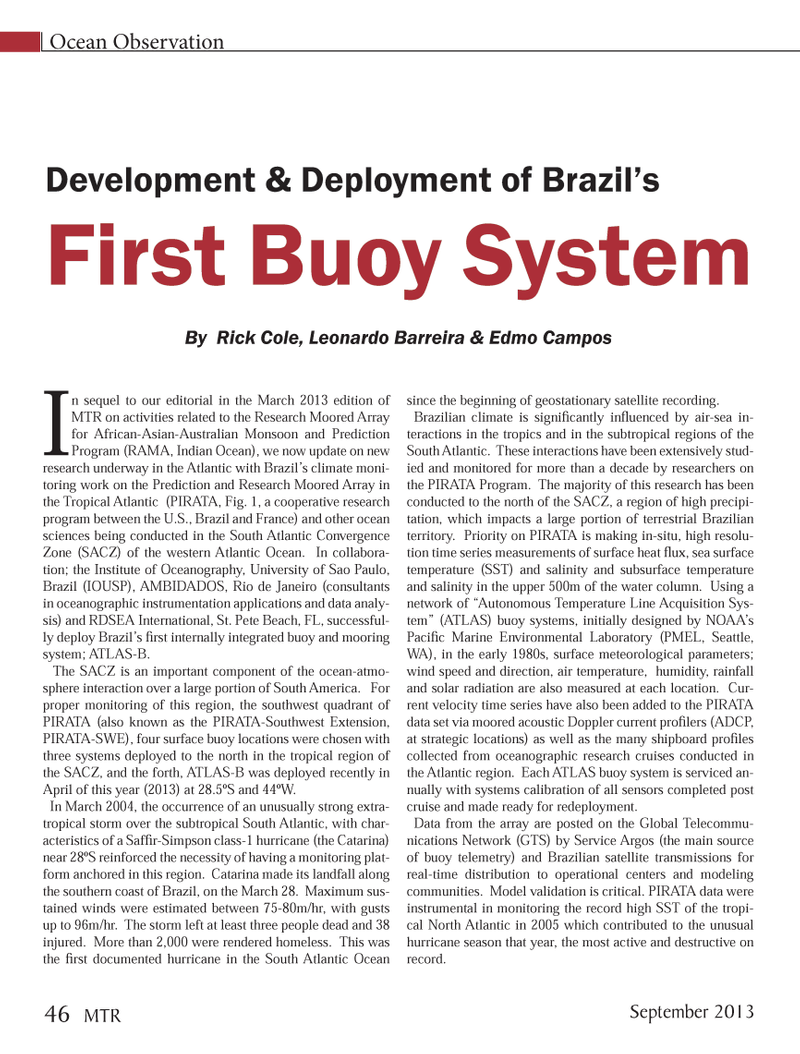
Page 46: of Marine Technology Magazine (September 2013)
Ocean Observation: Gliders, Buoys & Sub-Surface monitoring Networks
Read this page in Pdf, Flash or Html5 edition of September 2013 Marine Technology Magazine
In sequel to our editorial in the March 2013 edition of MTR on activities related to the Research Moored Array for African-Asian-Australian Monsoon and Prediction Program (RAMA, Indian Ocean), we now update on new research underway in the Atlantic with Brazil?s climate moni- toring work on the Prediction and Research Moored Array in the Tropical Atlantic (PIRATA, Fig. 1, a cooperative research program between the U.S., Brazil and France) and other ocean sciences being conducted in the South Atlantic Convergence Zone (SACZ) of the western Atlantic Ocean. In collabora- tion; the Institute of Oceanography, University of Sao Paulo, Brazil (IOUSP), AMBIDADOS, Rio de Janeiro (consultants in oceanographic instrumentation applications and data analy-sis) and RDSEA International, St. Pete Beach, FL, successful-ly deploy Brazil?s rst internally integrated buoy and mooring system; ATLAS-B. The SACZ is an important component of the ocean-atmo- sphere interaction over a large portion of South America. For proper monitoring of this region, the southwest quadrant of PIRATA (also known as the PIRATA-Southwest Extension, PIRATA-SWE), four surface buoy locations were chosen with three systems deployed to the north in the tropical region of the SACZ, and the forth, ATLAS-B was deployed recently in April of this year (2013) at 28.5ºS and 44ºW. In March 2004, the occurrence of an unusually strong extra- tropical storm over the subtropical South Atlantic, with char- acteristics of a Saf r-Simpson class-1 hurricane (the Catarina) near 28ºS reinforced the necessity of having a monitoring plat- form anchored in this region. Catarina made its landfall along the southern coast of Brazil, on the March 28. Maximum sus-tained winds were estimated between 75-80m/hr, with gusts up to 96m/hr. The storm left at least three people dead and 38 injured. More than 2,000 were rendered homeless. This was the rst documented hurricane in the South Atlantic Ocean since the beginning of geostationary satellite recording. Brazilian climate is signi cantly in uenced by air-sea in- teractions in the tropics and in the subtropical regions of the South Atlantic. These interactions have been extensively stud- ied and monitored for more than a decade by researchers on the PIRATA Program. The majority of this research has been conducted to the north of the SACZ, a region of high precipi- tation, which impacts a large portion of terrestrial Brazilian territory. Priority on PIRATA is making in-situ, high resolu- tion time series measurements of surface heat ux, sea surface temperature (SST) and salinity and subsurface temperature and salinity in the upper 500m of the water column. Using a network of ?Autonomous Temperature Line Acquisition Sys- tem? (ATLAS) buoy systems, initially designed by NOAA?s Paci c Marine Environmental Laboratory (PMEL, Seattle, WA), in the early 1980s, surface meteorological parameters; wind speed and direction, air temperature, humidity, rainfall and solar radiation are also measured at each location. Cur- rent velocity time series have also been added to the PIRATA data set via moored acoustic Doppler current pro lers (ADCP, at strategic locations) as well as the many shipboard pro les collected from oceanographic research cruises conducted in the Atlantic region. Each ATLAS buoy system is serviced an- nually with systems calibration of all sensors completed post cruise and made ready for redeployment. Data from the array are posted on the Global Telecommu- nications Network (GTS) by Service Argos (the main source of buoy telemetry) and Brazilian satellite transmissions for real-time distribution to operational centers and modeling communities. Model validation is critical. PIRATA data were instrumental in monitoring the record high SST of the tropi-cal North Atlantic in 2005 which contributed to the unusual hurricane season that year, the most active and destructive on record.Ocean Observation Development & Deployment of Brazil?s Development & Deployment of Brazil?s First B First B uoy System uoy System By Rick Cole, Leonardo Barreira & Edmo CamposSeptember 201346 MTRMTR #7 (34-49).indd 46MTR #7 (34-49).indd 468/22/2013 11:13:29 AM8/22/2013 11:13:29 AM

 45
45

 47
47
